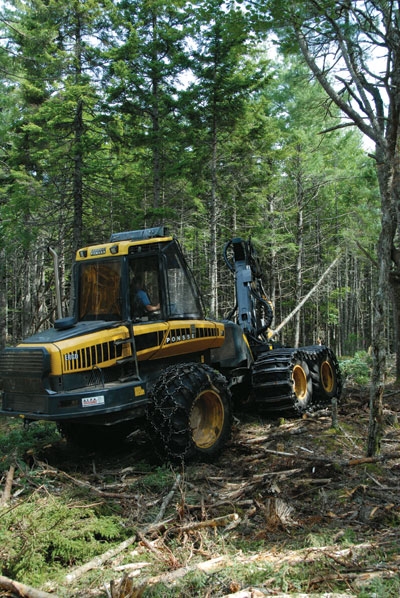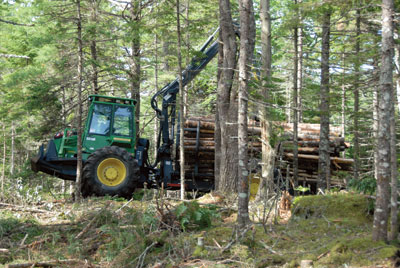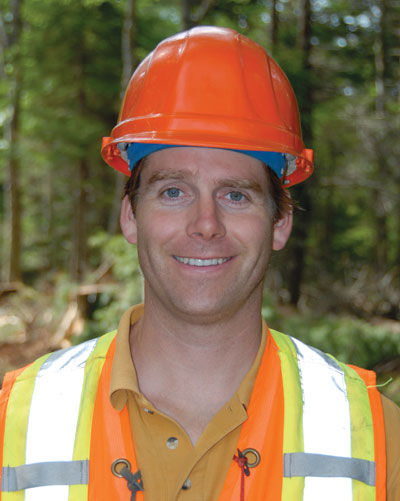
Features
Forestry Management
Harvesting
All in a Day’s Work
As anyone in the forest industry will tell you, the life of a logger is full of challenges, ranging from weather related delays to rapidly changing rules and regulations in harvesting blocks. Add a public watershed into the equation and they have even more to deal with. But for Beaver Dam Enterprises Ltd., a small logging contractor in Nine Mile River, N.S., it’s all in a day’s work.
November 14, 2011 By Bill Tice
 Beaver Dam’s Mark Thompson says the Ponsse Ergo they use in the Halifax watershed is ideal for the terrain and type of work they handle. As anyone in the forest industry will tell you
Beaver Dam’s Mark Thompson says the Ponsse Ergo they use in the Halifax watershed is ideal for the terrain and type of work they handle. As anyone in the forest industry will tell youBeaver Dam employees spend much of their summer months harvesting in the Pockwock Watershed, which is one of two main water sources for approximately 320,000 residents who call Halifax, N.S., home. It’s an arrangement that dates back to 1974 when the 4,850-hectare (12,000-acre) landbase became 100% crown land. Prior to that, the Elmsdale Lumber Co. Ltd. (ELCO) in Elmsdale, N.S., owned or held leases on 30% of the area, and at the time of the land transfer to the Nova Scotia Department of Natural Resources (DNR), they negotiated harvesting rights that would allow them to continue to harvest in the newly formed watershed to help supply their nearby mill with timber.
Six years later, Stephen Thompson, who is the woodlands manager at ELCO, was encouraged by the mill’s management team to venture into the contracting business. It was a good fit, as he knew the area and the company well. He grew up in the region and his father Downey, who still works for ELCO as a senior woodlands consultant, is the company’s longest-term employee at 62 years.
While continuing on with his day job at ELCO, Stephen started up Beaver Dam with one dozer, contracting it out for roadwork. He expanded into mechanized harvesting in 1993 when he picked up a Caterpillar excavator with a LogMax processing head and then went through various pieces of harvesting equipment before moving to a Ponsse Ergo harvester in 2002.
Father and Son Team
While building his logging company, Stephen continued on with his role for ELCO and brought his son Mark into Beaver Dam as a partner. “Mark came on board in 2002 and that allowed me to step away from the logging contracting side of things,” Stephen notes. “For about the last four years, Mark has really taken over the day-to-day running of the company and that includes managing much of what is going on in the woods.”

Today, Beaver Dam is still a small operation, but it is efficient, running one harvesting side with a crew of three. The original Ponsse has been replaced with a 2007 Ponsse Ergo, complete with a Ponsse head, and this past July they acquired an almost new John Deere 1010D forwarder from a local auction. They also have a 2000 Fabtek 344 forwarder that they use on occasion, and a 2001 Western Star log truck with a centre mount loader for moving wood to the mill. For road building, they use a Komatsu 200 excavator with a thumb and a Komatsu 31 dozer.
With a mandate for selection harvesting and the smaller cuts they need to do in the watershed, along with the limited logging season available to them due to weather, it’s a system that they have found works well for them.
“We only harvest in the watershed in the summer months,” Stephen says. “And even then, we are very weather dependent. If it rains and water is running down the road, we don’t want to porter (forward) as we can’t risk having any sediment running into the streams that feed the watershed.”
The type of logging Beaver Dam does in the watershed also lends itself well to their small and specialized crew. “All of our cuts are small volumes and they have averaged just 2.8 hectares each since 1999, and if we are not doing selection harvesting, we are doing variable retention,” Stephen adds. “Clear cutting is very limited in the watershed and is prescribed only where it is the most suitable option.”
Stephen says one of the main objectives in the watershed is “to maintain the natural Acadian Forest,” by leaving “long lived” species such as white pine, red spruce, yellow birch and hemlock. “Second only to water quality, that’s our goal and that is the direction we have from the Halifax Regional Water Commission (HRWC) and the Nova Scotia DNR.”
Water Quality

Barry Geddes, watershed manager with the HRWC and a registered professional forester, says Beaver Dam is diligent when it comes to their responsibilities in the watershed. “They must practice to a standard that is acceptable to both the water commission and DNR, as it is a jointly managed watershed,” he says. “To date, Beaver Dam has an excellent track record. I know that when they say they will do something, it gets done, and many times they have even gone that extra mile. For example, in the past they have come across border wetland areas that were not identified on the harvest map. Realizing the sensitivity and importance of these areas they knew to mark them out and work around them without question. This goes to show how conscientious they are and how important it is to have a crew who realizes the sensitivity of working inside a watershed.”
Having that much confidence in the crew that works in the watershed is important to Geddes and the HRWC. “Allowing harvesting activities in the watershed is of main concern to the public,” notes Geddes. “We receive phone calls on a regular basis questioning why we allow the harvesting to continue. There is a misconception that the water commission profits from the harvesting activities when in fact there is no financial gain to the commission at all. What many people don’t realize is the harvesting activities we are doing in the watershed maintain the forest at a level that will benefit the water supply and help us to continue to produce high water quality.”
He says if the forest is not managed properly they could have problems similar to those that have plagued various other watersheds where blowdown of unhealthy trees has created erosion problems, sediment issues and an increased risk of forest fires, all of which can adversely affect water quality.
“What we are doing is targeting the unhealthy trees,” adds Geddes. He says they are essentially “cleaning up the forest” and are doing it in a safe manner that protects water quality while ensuring sustainability of the forest resource. “Beaver Dam has to follow rigorous guidelines and utilize best management practices for just about everything they do. That means having buffers in place that meet or exceed provincial standards, following provincial fire regulations, having a spill plan and reporting mechanism in place, following gate locking procedures, having a communication plan, and having regular meetings with us to discuss any changes that may need to happen.”
Protection Plans
As for the HRWC, Geddes adds that they also must follow guidelines and provincial regulations that assure the Province and the public that the watershed and its supply are being managed responsibly. “As part of our operating permit, to withdraw water from any of our water supplies, the Province requires HRWC under the Environment Act to submit and implement a separate source water protection plan for each supply. Our plans include a raw water sampling program aimed at evaluating baseline water quality conditions (General Source Water Sampling). The results then can be used to monitor any changes that may occur during an activity. For example if harvesting activities are planned near any lakes or water courses, weekly tests will be conducted while the activity is occurring (activity based monitoring). If there are any changes to the water supply the activities can be modified or stopped altogether to stop the impact from occurring,” Geddes explains.
In addition to what they do on the ground, Geddes says the HRWC is extremely active in the community in terms of education and public awareness of watershed activities, such as harvesting. “We will go out and speak to community groups, we distribute community newsletters, we have developed a website, we hold open houses, we participate in research and development projects related to climate change, water monitoring and any other issues that might impact water quality, and we have advisory boards that consist of representatives of the HRWC, provincial bodies, local municipalities and community members. We use as many avenues as we can to get the message out that what we are doing in the watershed will benefit the city’s drinking water.”
For Beaver Dam’s Mark Thompson, doing things right in the watershed is just a given. “We are part of the Canadian Woodlands Forum Atlantic Master Logging Program and we already follow strict guidelines on all of the blocks we harvest, so it wasn’t difficult for us to implement the best management practices required for us to operate in the watershed,” Mark explains.
New Harvester
He also adds that the Ponsse is a great tool for the job at hand. “We can do things with the Ponsse that we could never do with a track machine,” he notes. “It has great manoeuvrability, we can stretch the boom into an area and pull wood out without damaging standing timber, and if we are cutting on a hill, we can move the wood to the bottom and then cut it for the forwarder. The only problem I have is the Ponsse can go places where our four wheel drive forwarder can’t, so we have to plan ahead when it comes to how we are going to handle a cut block, especially if the terrain is steep or rough.”
In Mark’s opinion, the Ponsse machines are the only way to go. In 2005, a trip to Finland for a visit to the Ponsse factory and the company’s demonstration harvesting site solidified his opinion on the quality of the Ponsse equipment. And since Beaver Dam purchased the new Ponsse in 2007, he says they have never looked back. “The new machine gave us improved reliability and of course with new motors and components, our productivity just went straight up,” he says. “I think the new machine does consume a little more fuel when compared to the old one, but we more than make up for that in increased production.”
As for the day-to-day operation of the Ponsse, Mark says, “it’s great.” In addition to having an ergonomically designed cab, he says servicing is a breeze. “Either I do the servicing or Shane Wells, who is our other harvester operator and a diesel mechanic by trade, does the work. And if we do need help from Ponsse, we just call our dealer in Truro, ALPA Equipment, and they provide the support we need.”
Both Mark and Stephen say it’s not difficult to harvest in the watershed, adding that it just takes common sense, while using the knowledge, skills and tools they already have. Or as Mark states, “It just means doing things the correct way, which we always do anyway.” Basically, it’s just another challenge that’s all in a day’s work.
Print this page